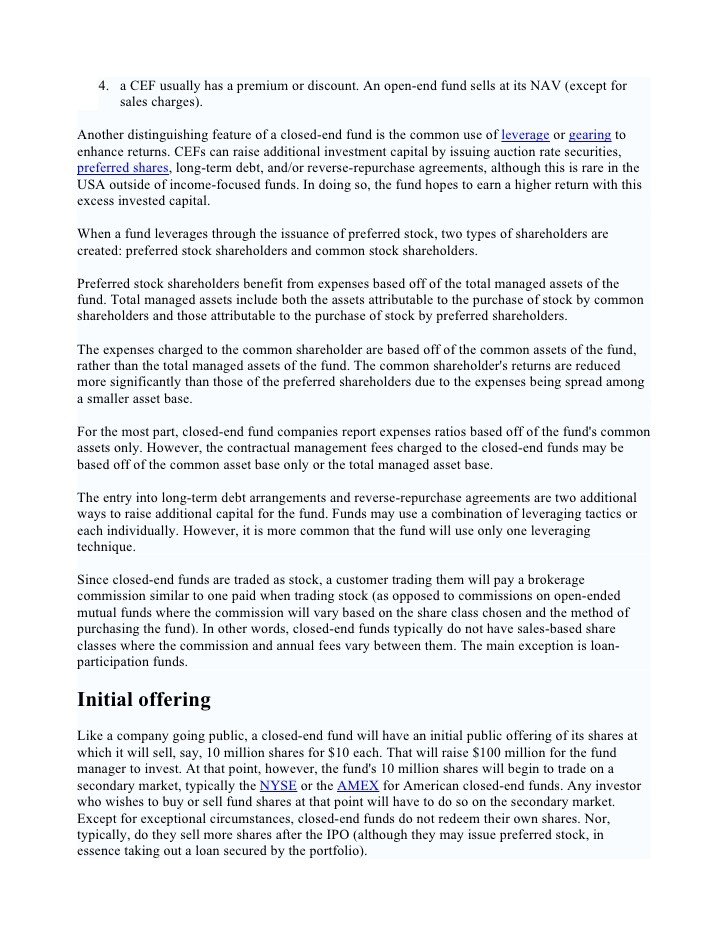Make Money with ClosedEnd Fund Activism
Post on: 16 Март, 2015 No Comment

Closed-end fund shareholders have traditionally been thought of as individual investors. But when last year’s market turmoil sent discounts to record levels, according to a December 2008 survey by Herzfeld Advisers and the Altman Group, market conditions have caused retail investors to flee closed-end funds and thus paved the way for institutional investors to get their way through increased shareholder activism. The potential immediate profit from open-ending or liquidating a CEF trading at a discount of 15% or so is quite attractive, even though trying to force through changes over the opposition of incumbent fund management resembles medieval siege warfare in its demands on time, resources and strategic planning.
One strategy that individual investors might consider would be to piggy-back on institutional activism, buying those CEF’s that seem to be most susceptible to discount reduction action in the near future. The factors that identify target funds might include:
- How large is the trading discount? (Bigger discount = more incentive to act.)
- How large is the fund? (The profit from closing the discount on a very small CEF might not be worth the effort, and even institutions might find it difficult to build positions in the largest CEFs. Hunters don’t usually stalk mice or hippos.)
- Is there any clear benefit from keeping the closed-end format? (For instance, an illiquid portfolio or many hard-to-value holdings?)
- Is the fund an acceptable holding even if the discount doesn’t change?
- What are the underlying investments? (Stock funds have bigger discounts, but bond fund returns are more predictable for investors and activists.)
- Has the CEF consistently beaten its benchmarks? Or is it a loser?
- How much do institutions own? (They must file Form 13F every quarter to report holdings, and various online services summarize and analyze this data.)
- Are the institutional owners willing to support discount reduction activism? (Many are brokers or sponsor other CEFs, and prefer the status quo.)

Over the years a few courageous souls have developed reputations for getting results as CEF activists: Phil Goldstein of Bulldog Investors, George Karpus of Karpus Management and Art Lipson of Western Investments are regular names on SEC filings that disclose >5% ownership of a fund or the start of a proxy contest. But in addition. there are over a dozen more hedge fund-type institutions with assets in the $100 million+ range that keep showing up on CEF shareholder lists, where a review of their portfolios shows that they specialize in or emphasize owning CEFs.
The 13F filers that appear to have the most to gain from discount reductions include the following names, in addition to Karpus and Western (Goldstein’s Bulldog Investments does not file 13F forms): 1607 Capital, City of London, Cornerstone, Doliver, Financial & Investment, Gramercy, Punch Associates, Relative Value, Rivernorth, Rockwood, Summit Capital, Technical Financial, Wolverine and Yieldquest. These secondary players, who altogether control over $5 billion, are not nearly as well known as the leading activists: they keep their ownership of CEF’s under the 5% threshold for filing a Schedule 13D or 13G, and they appear content to profit by playing follow the leader. Their support may be crucial in CEF proxy contests, where the voting turnout by individual investors tends to be quite low. As the Investment Company Institute reported back in 2007 :
Even though closed-end fund shareholders are solicited annually by their funds to elect directors, many shareholders still do not vote. for half of closed-end funds, beneficial owners voted at most 31% of their shares held in street name.
To test the potential for institutional activism, ten CEFs were selected for examination: ASG, DHG, FGF, GRX, HQH, NFJ, RTU, SCD, SLS and USA. All are US equity or equity-income funds that have recently traded at discounts above 15%. An online database of 13F filings as of 6/30/09 showed total institutional holdings were more than 15% for all but one of these funds (NYSE:GRX ). The high was the 36.7% institutional ownership of FGF, a multimanager growth equity fund organized in July, 2005 with a current market cap @ $200mm and a recent trading discount of about 16%. The sixteen institutional investors listed above, i.e. activists and followers, together appear to own about 18% of FGF.
Any predictions? Anyone want to bet whether FGF will be the target of institutional activism in the next year or so? What about DHG? Here’s the list:














